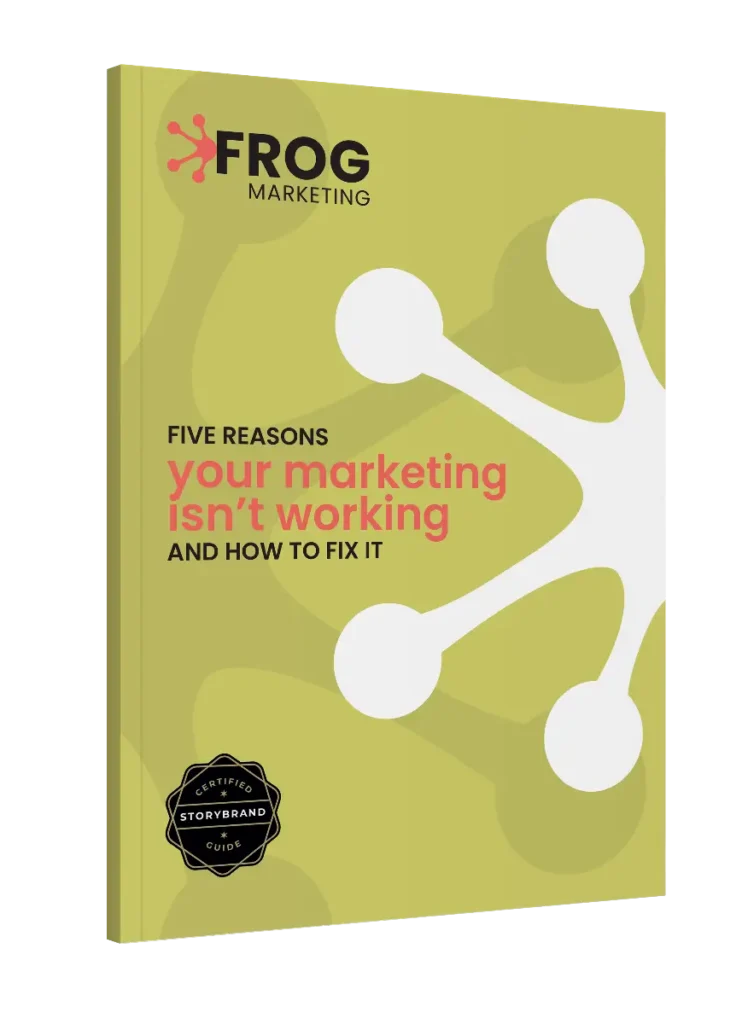Ask ten marketing consultants what you should spend on marketing and you’ll get ten different answers. Ask your finance director and you’ll get ‘as little as possible.
But the truth is, there’s no magic number that works for everyone. There are however proven frameworks, industry benchmarks, and strategic approaches that can guide you to the right investment for your specific situation.
Before we get into the numbers, there’s one crucial point on mindset to address: don’t think of your marketing budget as merely an expense – it’s far more than this – your marketing budget is an investment in your future revenue.
Studies show that today’s buyers complete up to 70% of their decision-making before ever reaching out. That means your content marketing, thought leadership, and of course perhaps most importantly your website, aren’t just nice-to-haves – they’re essential to your sales process.
What Do Most UK Businesses Actually Spend?
According to the latest UK industry data (2024/25), the picture varies significantly by company size and industry. Most established UK businesses spend between 5-10% of revenue on marketing, but it varies quite a bit depending on your industry, growth stage, and business model.
If you’re an established business with steady revenue, you’re typically looking at 5-8%. But if you’re in growth mode and actively trying to win market share, 10-15+% isn’t unusual.
That said – companies with high overheads or project-based models often find this percentage-based approach very misleading. If you only need 6-12 high-value clients per year, working backwards from your Customer Acquisition Cost makes far more sense. We go into this in more depth further down the article with a project based calculator for identifying the right budget for you.
What's the Right Percentage for Different Growth Goals?
Practically – what should you be thinking of investing based on your growth ambitions:
To Maintain or Shrink (5-8% of revenue): If you’re happy with your current size or facing market pressures, this conservative approach helps maintain visibility whilst controlling costs. You’re essentially trying to hold your position in the market.
For Steady Growth (10-12% of revenue): This is the sweet spot for most established UK businesses wanting consistent, sustainable growth. You’re investing enough to stay competitive and capture new market opportunities without overextending.
For Aggressive Growth (12-15%+ of revenue): When you’re after aggressive growth, entering new markets, or scaling rapidly. Technology and software start-ups in the UK often invest between 10-20% of their revenue in marketing efforts to establish themselves in rapidly developing markets.
What if this formula isn’t right for your business?
Are you a high project value, very low customer volume needs, with high project overheads? i.e. A premium landscaping or building company working on incredibly high value projects but spending a lot of money on machinery and materials?
If this is your model the % formula above may not be that useful. The key then, is deciding what one customer is worth. Or to put it another way: How much can you afford to spend to win one customer while still being profitable.
In this scenario:
Work out average profit per client (before overheads)
Profit in this context is after things like materials, external specialists and machinery, but before items like insurance, staff wages (including directors and anyone earning a living from the company), rent, admin etc. The usual costs of running a business.
Decide on maximum acceptable cost per acquisition (CAC)
An industry benchmark is 3:1 ratio (profit: acquisition cost). I.e. if you spend £1 on marketing it should generate £3. However this tends to be more common in tech/SaaS where customers have high lifetime values and recurring revenue.
For project-based businesses (i.e. landscaping, construction, consulting) where each client is essentially a one-time project, 5:1 or 7:1 is much more realistic. Likewise high overhead companies are often looking for more like 5:1, 7:1, even 10:1. In this case your marketing and crucially your marketing strategy needs to be incredibly effective.
The key insight here is that while 3:1 might be the theoretical benchmark, project based businesses and businesses with higher overheads (equipment, premises, staff) likely need higher ratios to maintain profitability.
Budget your marketing based on the number of clients you need × CAC
NOTE: The reason we don’t include overheads in these calculations is that they are mostly fixed – you pay them whether you win 6 clients or 8. What you need to test is: “Does acquiring this client add more contribution than it costs to acquire them? If yes then they’re worth acquiring.
Want to run your numbers? Use our Marketing Budget Calculator to work out exactly how much you should invest based on your client value and acquisition goals.

But What If I Have No Revenue Yet?
This is the classic start-up dilemma. If you’re just starting out, these percentages feel meaningless because you don’t have revenue to calculate from.
For new businesses, think in terms of what you can afford to spend to acquire each customer, and how long will it take to recoup that investment?
Many successful start-ups begin by investing whatever they can afford – whether that’s £500 a month or £5,000 – and then scale their investment as revenue grows.
How Do I Know If My Marketing Investment Is Right?
The truth is businesses rarely spend too much on marketing. What looks like overspending is usually just ineffective marketing – wrong message, wrong audience, or wrong channels.
If your marketing is genuinely working, the “problem” you’ll face isn’t budget – it’s capacity. You’ll have more leads than you can handle, which whilst it feels like a nice problem to have, can actually damage your business through poor customer experience which will eventually damage your reputation.
If this is happening, you don’t necessarily need to cut marketing spend – you need to either increase capacity, raise prices, or become more selective about who you work with.
The real issue for most UK businesses is underspending.
Warning Signs You're Underinvesting:
Revenue stagnation despite market growth: Your industry is expanding but your revenue isn’t. Your competitors are likely out-investing you in customer acquisition.
Over-dependence on referrals: Whilst referrals are wonderful (and particularly important in the UK market), relying on them exclusively means you’re not actively building market presence. What happens when your main referral sources dry up or move on?
Long, painful sales cycles: If prospects take forever to convert, you’re probably not investing enough in nurturing and education through content marketing and thought leadership. Remember – buyers complete up to 70% of their decision-making before ever reaching out. Ensure you have enough content for them to engage with and inform an opinion of you as a business.
Feast or famine revenue patterns: One month you’re slammed, the next you’re scrambling for work. This usually means you only market when you’re quiet, rather than maintaining consistent visibility.
Your competitors are more visible than you: They’re showing up in searches, speaking at events, publishing content, and generally being seen as the authority.

Warning Signs Your Marketing Isn't Working (Regardless of Spend):
These are the symptoms that tell you something’s fundamentally wrong with your strategy or execution, rather than your budget:
- Wrong people are getting in touch – you’re attracting tire-kickers, price shoppers, or people completely outside your target market. This is almost always a messaging problem.
- Lots of activity but no conversions – your website traffic is up, you’re getting lots of likes on social media but no one is actually getting in touch. Again this is likely a messaging problem or lack of compelling call to action.
- You can’t answer “where did our last 5 clients come from?” If you don’t know what’s working, you can’t do more of it. Track, track, track!
- Leads have no idea what you really do – again a messaging problem! But also your marketing isn’t pre-educating them.
- You’ve spent on 10 different things this year with nothing to show for it – no strategic focus which is usually not having a clear strategy, which results in jumping from tactic to tactic without giving anything time to work.
The Key Question:
Don’t ask “Am I spending too much?” Ask “Is what I’m spending generating profitable customers?”
If yes – brilliant. Scale it up until you hit capacity, then increase prices or capacity.
If no – you don’t have a budget problem, you have a strategy, messaging, or execution problem. Cutting the budget won’t fix this you need to get clear on who you serve, what you offer, and how you communicate it.
What Should Businesses Spend Their Marketing Budget On?
This will be different for every business and should dictated by your marketing strategy. If this is something you’re not clear on, take a look at our ‘How to create a Strategy For Marketing’ page.
The sorts of things you might spend marketing budget on are:
Foundation: Your website and core messaging – the basis of successful marketing. This includes getting absolutely clear on who your customers are, what they want, how they feel and how you can help them.
Lead Generation: Reaching these customers you have identified: SEO, Google Ads, LinkedIn (crucial for B2B), content marketing that answers your customers’ burning questions.
Nurture & Authority: Building trust over time: thought leadership, PR, speaking, email sequences that educate rather than sell.
Testing, Optimisation & tracking: New channel experiments, A/B testing, data analytics – understanding what’s working and what is not, so that you know what to do more of or cut out altogether
What If I Can't Afford the 'Right' Percentage?
Not every UK business can immediately invest 10-15% of revenue in marketing, especially given current economic pressures. Here’s how to approach constrained budgets:
Focus on High-Impact Activities: Prioritise activities that directly generate leads over brand-building exercises.
Leverage Free and Low-Cost Channels: Content marketing, SEO, and organic social media can deliver significant returns with primarily time investment. The key is getting your messaging right and answering your customers key questions.
Measure Everything: With a limited budget, you need to account for every pound. Make sure you are tracking what is bringing you leads and what isn’t.
Get stuck in: Figure out what you can do yourself versus what you need someone else to do for you and block out time in your diary to do it.

How can I make my Marketing Budget go Further?
In truth most businesses spend too little on marketing, not too much. The problem is they’ve tried various marketing tactics in the past and haven’t seen a great return. No one wants to throw money away so budgets get cut.
But ineffective marketing is so often a messaging problem. Not having a deep understanding of who the main customer is, what their problem is and how you help them means you’re saying the wrong things to the wrong people in the wrong way.
If you have a messaging strategy that clearly identifies your main customers and their biggest problem, then effectively communicate how you can solve it and implement the most effective way of reaching them at various different points of the buying cycle, you will really start to see results.
This is exactly where the StoryBrand framework excels – so much marketing advice focuses on ‘helping you to tell your story’ but customers don’t care about your story. They care about their problem and whether you can solve it. Clarify your message so that the customer is the sole focus and your results will be so much better.
And, once you get it right – consistent, strategic marketing investment is what drives sustainable growth – particularly in our increasingly competitive market.
Next Steps
Inactivity is the enemy of progress. Start with these actions:
- Calculate your current marketing spend as a percentage of revenue – you might be surprised how little it actually is
- Benchmark against your industry – use the UK-specific frameworks in this article as a starting point, or use our calculator
- Audit your current activities – what’s working, what isn’t, and where are the gaps?
- Create a 12-month plan – align your marketing investment with your revenue goals
- Set up proper tracking – you can’t optimise what you don’t measure
Often the question isn’t whether you can afford to invest in marketing – it’s whether you can afford not to. The businesses that are thriving are those that are investing – whether that’s time or expertise.
Start with what you can afford, measure everything, and scale your investment accordingly as you see results.
Ready to create a marketing strategy that delivers real results?





